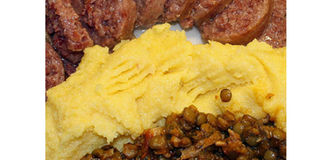New Year traditions in Europe

Cotechino with lentils and polenta, a popular New Year’s dish in Italy.
What you need to know:
MY DENMARK DIARY. As 2012 comes to an end, there will be a lot of celebration in the air. The writer will be taking part in a number of New Year “rituals” with her friends in Denmark, some quite amusing.
All over Europe, New Year is celebrated with unique traditions that vary from country to country, from one region to another. Studying in an International class, I have come to learn that New Year celebration is different in Germany, Denmark or Spain.
However, the idea is centred on one thing, celebrating with friends and to my utter astonishment performing what I would call, “rituals” in some countries in the South of Europe, in order to begin and end the new year with good luck.
In Denmark, the Queen’s speech broadcast on radio and television is one of the highlights of New Year’s Eve, punctuated by the striking of the Town Hall clock in Copenhagen at midnight. The speech is symbolic and important in cementing the national sentiments among the Danes and dates back to 1942 during the German occupation when the King called for unity among Danish peoples.
The festivities are characterised by a menu of cod and pork, a delicacy enjoyed immensely by the Danes, and later fireworks to usher in the New Year. Since the Danes and many Europeans are far from religious, church would probably be the last place to find young people especially on a New Year’s Eve.
In Germany, the New Year’s Eve known as Silvester, is also marked by partying and fireworks. The fireworks or Feurewerk in German are said to drive off evil spirits through their loud noises and sparkling.
A friend of mine from the region of Bavaria in Southern Germany, says what makes New Year’s Eve particularly special is the need to dress for the occasion. Unlike any other ordinary day of the year, special attention is made on what one should wear, as there are endless parties all over big cities like Hamburg and a magnificent display of fireworks that urshers the New Year in in-style.
In Northern Spain, the tradition is to eat a grape at each strike of the clock 12 seconds to midnight. As my friend explained, you have to be fast enough to eat a grape within every second as the clock slowly approaches to the 12th hour.
This, I thought, should take particular practice and skill, especially if the grapes are as big as marbles. This practice is symbolic in ushering in good luck into the New Year. Italians in Sicily prefer to start the New Year by throwing out old furniture, clothes, and pans through the window.
This symbolises letting go of the past and embracing the future.
In Como, South of Italy, there is a special food that should be eaten on the first day of the New Year consisting of lentils and sausages. Although the dish is quite heavy to consume, it is meant to symbolise money, wealth or abundance for the New Year.
On the Faroe Islands, New Year is ushered in with a bonfire, and a display of fireworks, with people toasting to champagne and all sorts of wines and beers.
Thereafter, people head to private parties at their friend’s places or their families. Dinner is made up of dry whale meat and fish together with beer or wine, while listening to radio shows that round up the political highlights of the year with humour and satire.
This year, I have decided to try and combine some of these traditions that I have learnt from some of my friends, and those from home, only hoping for a wonderful and prosperous 2013!




